After a few hours of free-ranging, I call the hens back home. Everyone comes quickly. They know that this is the only time that they get scratch grains. When they are back in the run, I count. There should be eleven chickens.
I count ten. Misty is missing.
She has dreams of being a wild jungle fowl, that elusive Indonesian bird that our domestic chickens are descended from. Or, maybe, she imagines that she is her late, late, late ancestor, a dinosaur. Whatever. I have to find her. I look in the tall grasses of the meadow, where she sometimes builds a nest. She isn’t there. I check the overgrown raspberry patch.
She’s there, well-hidden, but I see movement.
Misty, the carnivore, is busy looking for crawling and wiggling things to eat. She cares not a whit that her flock mates have all hurried home to grain and safety. She is a wild jungle fowl!
I manage to get her back onto the lawn. I shake the can of corn and she remembers about the easy pleasures of domesticity.
Misty comes running.
It’s not difficult to tame the wild jungle fowl.
Do you have one in your flock?

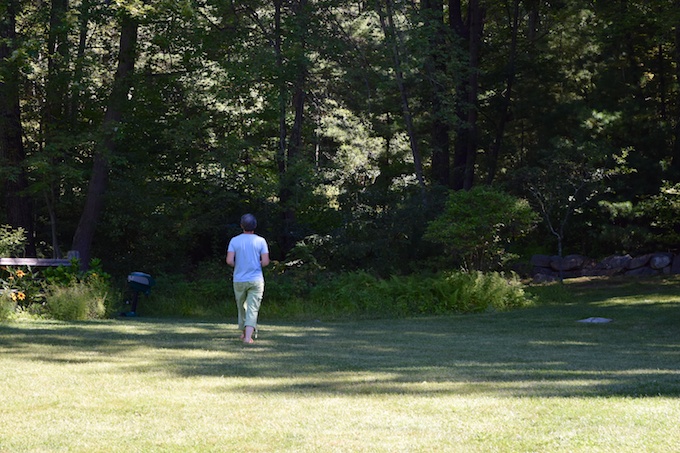

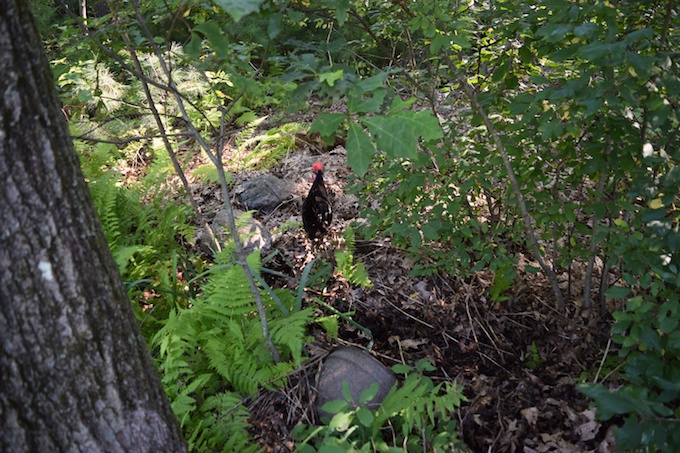
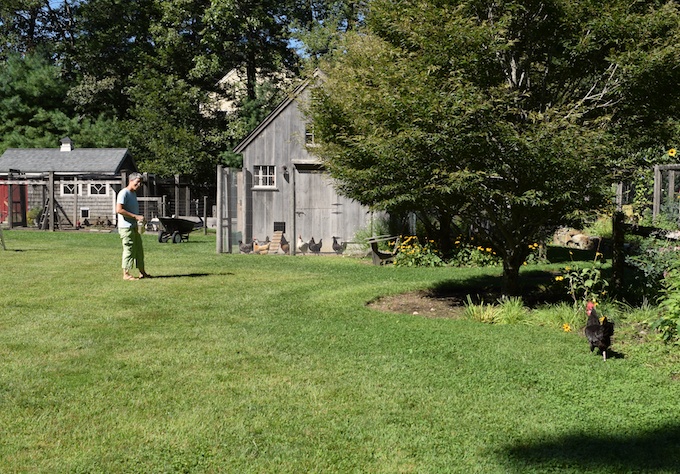
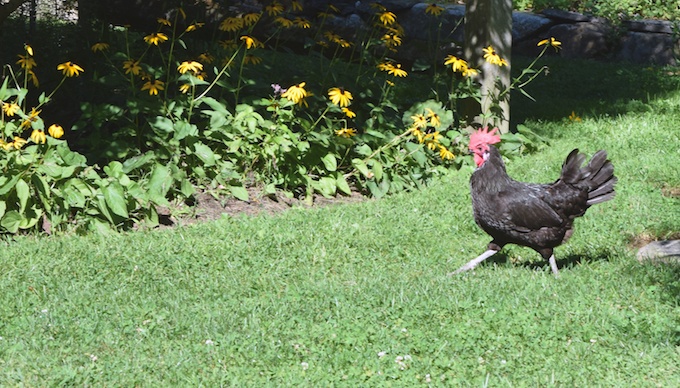
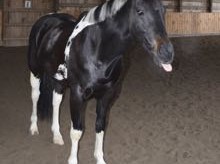
Our wild fowl is an Australorp named Poe who enjoys doing her own thing. I think that having a flock of mixed varieties and colors makes it much easier to do that head count at the end of the day.
Well, we know where those broody Orps are! :)
I had a Columbian named McQueen…remember the Great Escape? She used to go on the run every day, hide in the tree tops. I once saw how dinosaurs learned how to fly. McQueen grabbed the tree trunk with her claws, used her beak as a climbing tool, all the while flapping her wings as hard as she could. She worked her way up 25 feet into a sugar maple, then surveyed the surroundings like a pterodactyl from a sturdy limb. It was easy for her to scale the six foot chicken wire fence!! Our hens still have those wild genes, for sure.
I would have liked to have seen that!
She sat up there for hours, eating bugs and leaves. Later she just coasted down like a flying squirrel, albeit an ungainly one. She did not roost in the tree, just foraged there. She lived to six years, her coop mates are now eight…and still laying!
Marvelous! You are certainly doing much right to have such a flock.
HILARIOUS!!
My Appenzeller Spitzhauben bantam gets the “wild fowl” award in our flock. She’s happiest when she’s free ranging deep in the brush under the trees that edge the back of our property. Like Misty, she couldn’t care less if her flockmates aren’t right there with her. It’s often been a challenge to tempt her back to the run with treats unless it’s almost time to roost for the night anyway. At least she prefers the safety of the coop at night to roosting in the trees. :-)
Neat breed!
Mine is a blue lased wyondotte. That hen for such a big bird scoots around the yard like three year old on a sugar high.
Always the last one end at night and at times she waits so long that when she does go in it is too dark in the coop for her to find her way onto the roost. So I have to do it.
My Wyandottes were also more assertive in the flock. Pretty birds, but not my favorite breed.
What a wonderful story! I can’t help but chuckle because there’s always one in the flock who feels the need to do her own thing…mine is a silver laced wyandotte named Sylvia…always illusive and independent, that’s our Sylvia. :) Terry, I see in the photos you have a mosquito magnet. We are considering purchasing one, do you recommend it?
Works brilliantly, when it’s working. They do have quality issues. And you have to figure out the right placement. But, because of our mosquito magnets, I can garden even in the shade.
My wild child is my five month old easter egger violet, but violet is now virgil, shes a he. Found someone to take him, I like the crowing but dont like the way hes pinning down the girls, so with a heavy heart, I have to say goodbye to him.
Well, that explains it. The boys are usually the more adventurous (but not always!)
This post made me smile. :) My crazy girl is “Rexie” ( funny enough, named by my son after a dinosaur!) She’s a loner and doesn’t like to associate with the other girls so she finds her cool spot under our lilac bush and loves her peace and quiet.
It’s the hens that aren’t’ so attached to the flock that make my best school visit chickens.
Yes I do! her name is Ivy. She stays out for about an hour after all the others have gone up to roost! Although she is the same Marans x RIR hybrid as Ivy and dear old placid Phoebe, Ivy is fast and nippy. She isn’t ‘friendly’. She certainly has wild ancestral genes!
C xx
It’s funny how some hens have a different bedtime. Some hurry in at the first moment of dusk, and others…
My Golden Campine `Barbie` is the only Chicken here that will fly up over the 8 foot gate to enjoy all the tasty plants and bugs on the other side of our garden. She usually only strays for a short while looking so proud that only she has the expanded territory all to herself then returns on her own to join her flock-mates. Her best mate `Lucky` the bantam leghorn rooster only joined her once but was nervous and was anxious to be back in familiar territory. It seems those visits are the only time she is not by his side. I guess she needs some alone time, and knows where to get it, smart girl.
Those Campines are gorgeous – but definitely retain a lot of the wild traits.
I have no hens…yet! :^)
But I was wondering- aren’t toads and those little orange newts poisonous? How would one manage the hen’s foraging?
After I wrote, I checked the HenCam FAQ’s- sounds like toads don’t agree with them.
And I can’t believe the July 23rd blog- that video is so hilarious! -that toad slurps down the beetles without even batting an eye! I was lucky to see some young toads, newts and garter snakes this summer in NY. Most of the time they were trying like mad to get away from me.
That’s why those newts are colored the way they are – a clear “beware” sign. Besides, a foraging hen has a wide range to choose from. A peck of something bad won’t hurt them, and they learn not to eat a lot of anything toxic. Penned animals don’t have as much sense.
Misty looks like she was having fun out there. Not keeping track of time. Chickens sure love to forage ;)
Time? The only time that she knows is daytime and nighttime :)
I did have one trying to go jungle. The first time I let my Dutch Bantam out to the garden, I said “go get some bugs”. What she heard was “go burrow into the weeds and raise a clutch of chicks”. Had to search around, but eventually found her among some tall grass she was turning into a nest. This was a few months back. Now that the Reds I have are full grown, they torment her so much that I just let her out to wander. Also, our roo is an active treader, so I don’t want her squashed flat by his hefty bulk. She never leaves the yard, and always goes to bed on time, in a separate cage I arranged for her. I find her most often outside the others’ pen just showing off that she is given permission to wander while they are not.
Those bantams :)